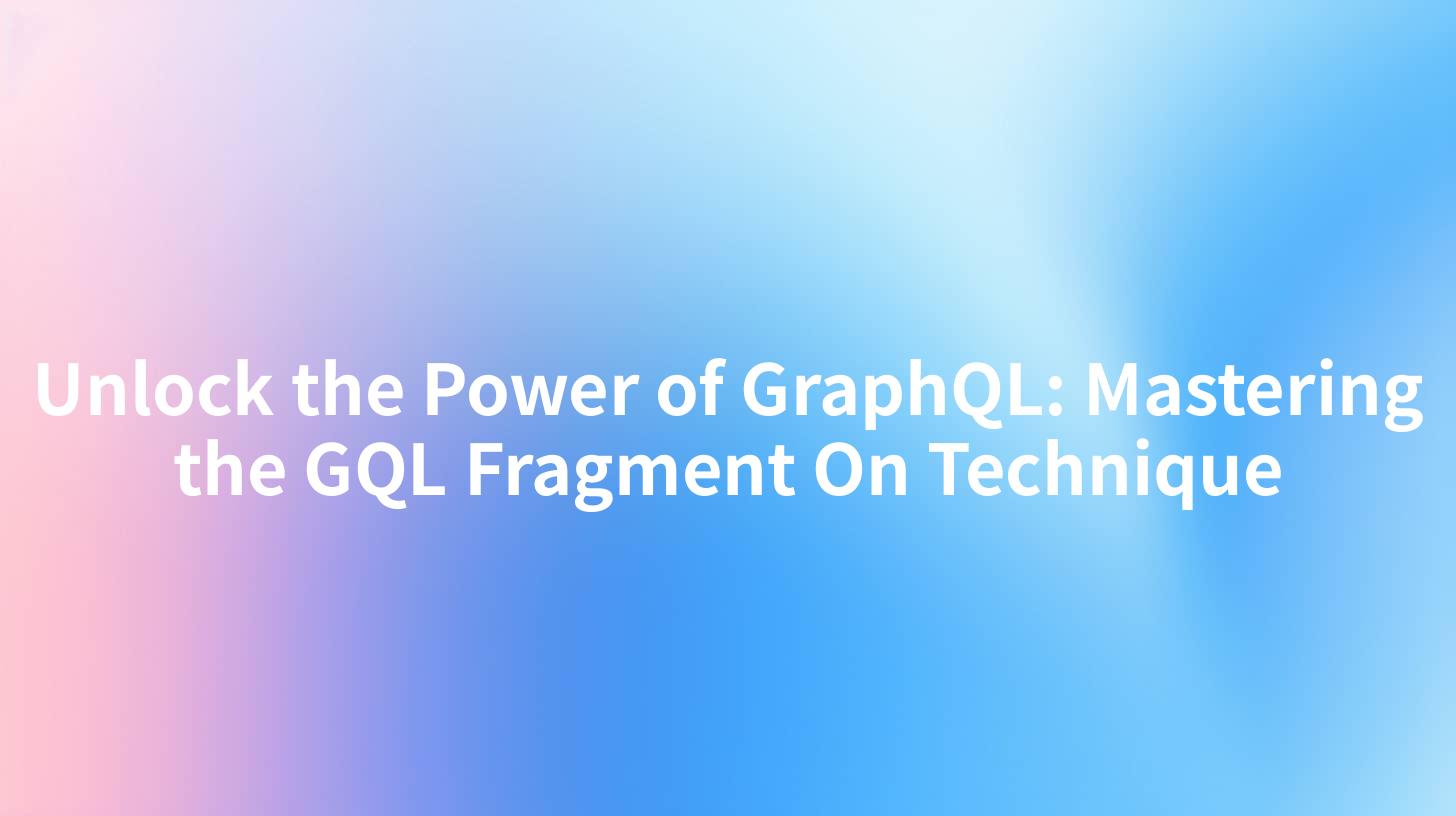Unlock the Power of GraphQL: Mastering the GQL Fragment On Technique

GraphQL, a powerful and flexible data query language, has revolutionized the way developers interact with APIs. One of its key features is the ability to use fragments, which allow for the reuse of query patterns. This article delves into the GQL Fragment On technique, providing an in-depth guide to mastering this feature. We will also explore how APIPark, an open-source AI gateway and API management platform, can enhance your GraphQL development experience.
Introduction to GraphQL
GraphQL is a query language for APIs and a runtime for executing those queries with your existing data. It provides a more efficient and flexible alternative to traditional REST APIs. GraphQL allows clients to request exactly the data they need, in the format they need it, and at the time they need it.
Key Benefits of GraphQL
- Flexibility: Clients can request the data they need, without over-fetching or under-fetching.
- Type Safety: GraphQL uses a strongly-typed schema, which helps prevent errors and ensure data consistency.
- Query Efficiency: Clients can combine multiple queries into a single request, reducing the number of round trips to the server.
Understanding GQL Fragments
A GQL fragment is a reusable piece of a GraphQL query. It defines a query pattern that can be included in multiple queries. Fragments are particularly useful for reusing common query patterns, such as a user's profile information.
Syntax of GQL Fragments
A GQL fragment consists of a fragment keyword, followed by a name, a type condition, and a selection set. Here's an example:
fragment UserProfile on User {
id
name
email
}
This fragment defines a pattern for querying a user's profile information. It can be included in any query that returns a User type.
APIPark is a high-performance AI gateway that allows you to securely access the most comprehensive LLM APIs globally on the APIPark platform, including OpenAI, Anthropic, Mistral, Llama2, Google Gemini, and more.Try APIPark now! 👇👇👇
Mastering the GQL Fragment On Technique
The on keyword in a GQL fragment is crucial for ensuring that the fragment is applied correctly. It specifies the type that the fragment should be applied to. Here's how to use it effectively:
Using the on Keyword
When using the on keyword, you must ensure that the type specified matches the type of the object in the query. Here's an example:
query {
user(id: "123") {
...UserProfile
}
}
In this query, the UserProfile fragment is correctly applied because the user field returns a User type.
Avoiding Type Mismatch Errors
One common issue with fragments is a type mismatch error. This occurs when the type specified in the fragment does not match the type of the object in the query. Here's an example of a type mismatch error:
query {
user(id: "123") {
...UserProfile
}
}
In this query, the UserProfile fragment is incorrectly applied because the user field returns a User type, but the fragment is defined for a Profile type.
Enhancing GraphQL Development with APIPark
APIPark is an open-source AI gateway and API management platform that can significantly enhance your GraphQL development experience. Here's how APIPark can help you master the GQL Fragment On technique:
APIPark Features for GraphQL Development
- API Gateway: APIPark serves as an API gateway, allowing you to manage and route GraphQL requests.
- API Management: APIPark provides comprehensive API management features, including versioning, security, and analytics.
- Documentation: APIPark automatically generates detailed API documentation, making it easier to understand and use your GraphQL APIs.
Integrating APIPark with GraphQL
To integrate APIPark with your GraphQL API, follow these steps:
- Deploy APIPark in your environment.
- Configure your GraphQL server to work with APIPark.
- Use APIPark to manage and route GraphQL requests.
Conclusion
Mastering the GQL Fragment On technique is essential for efficient and effective GraphQL development. By understanding how to use fragments and the on keyword, you can create more flexible and maintainable GraphQL APIs. Additionally, tools like APIPark can significantly enhance your GraphQL development experience by providing features like API management and documentation generation.
FAQs
1. What is the purpose of the on keyword in a GQL fragment? The on keyword specifies the type that the fragment should be applied to. It ensures that the fragment is correctly applied to the object in the query.
2. Can a GQL fragment be applied to multiple types? No, a GQL fragment can only be applied to a single type. If you need to apply a fragment to multiple types, you will need to define multiple fragments.
3. How can I avoid type mismatch errors in GQL fragments? To avoid type mismatch errors, ensure that the type specified in the fragment matches the type of the object in the query.
4. What are the benefits of using GQL fragments? GQL fragments provide flexibility and reusability in your GraphQL queries. They allow you to define reusable query patterns and apply them to multiple queries.
5. How can APIPark enhance my GraphQL development experience? APIPark can enhance your GraphQL development experience by providing features like API management, documentation generation, and an API gateway. These features make it easier to manage and maintain your GraphQL APIs.
🚀You can securely and efficiently call the OpenAI API on APIPark in just two steps:
Step 1: Deploy the APIPark AI gateway in 5 minutes.
APIPark is developed based on Golang, offering strong product performance and low development and maintenance costs. You can deploy APIPark with a single command line.
curl -sSO https://download.apipark.com/install/quick-start.sh; bash quick-start.sh

In my experience, you can see the successful deployment interface within 5 to 10 minutes. Then, you can log in to APIPark using your account.

Step 2: Call the OpenAI API.


